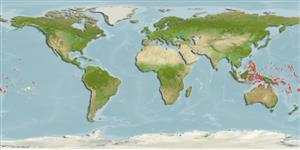分類 / Names
共通名の | 類義語 | Catalog of Fishes(部類, 種) | ITIS | CoL | WoRMS | Cloffa
>
Blenniiformes (Blennies) >
Blenniidae (Combtooth blennies) > Salariinae
Etymology: Blenniella: Diminutive of blennius, Greek,blenios = mucus (Ref. 45335).
More on author: Günther.
Environment: milieu / climate zone / depth range / distribution range
生態学
海 関連する礁; 深さの範囲 0 - 3 m (Ref. 90102). Tropical; 16°N - 24°S
Pacific Ocean: southern Japan to the Moluccas, east to Mariana Islands, Tonga, and Tuamoto Archipelago; Tawara, Kiribati and Howland Island. Replaced by Blenniella cyanostigma in the Indian Ocean (Ref. 37816).
サイズ / 重さ / 年齢
Maturity: Lm ? range ? - ? cm
Max length : 8.2 cm SL オス/雌雄の選別がない; (Ref. 9962); 6.8 cm SL (female)
背面の脊椎 (合計) : 12 - 14; 背鰭 (合計) : 19 - 22; 肛門の骨: 2 - 3; 臀鰭: 20 - 23; 脊つい: 37 - 40. Diagnosis: Dorsal fin XII-XIV, 19-22, notched between spinous and segmented-ray portions; anal fin II-III, 20-23 (rarely 23); pectoral rays 12-15 (usually 14); pelvic fin I, 3; caudal fin procurrent rays 10-16, segmented rays 13. Vertebrae 10-12 + 26-29. Last pleural rib on 11-13th vertebrae. Orbital cirrus simple filamentous; nasal cirri short and simple to palmate with 2-7 branches; nape without cirri. Lateral line, continuous anterodorsally below dorsal spines from 6-7th to 10th, disconnected posteroventrally up to below dorsal spine 9-13th. Mandibular pores 3-7 Lips margin entire. Occipital crest present, higher in males (Ref. 9962). Body depth at anal-fin origin 5.8-7.3 in SL. Male crest yellow; body greyish, shading ventrally to white, with 9 brown or olive vertical bars on side, and some horizontal streaks on middle of body (Ref. 90102). Females have numerous longitudinal pinstripes on their sides and black specks on their fins while males have dark patches and small blue spots on their sides (Ref. 37816).
Adults inhabit exposed shallow shores (0-3 m) and often found in tidepools (Ref. 90102). Oviparous. Eggs are demersal and adhesive (Ref. 205), and are attached to the substrate via a filamentous, adhesive pad or pedestal (Ref. 94114). Larvae are planktonic, often found in shallow, coastal waters (Ref. 94114).
Life cycle and mating behavior
Maturities | 繁殖 | Spawnings | Egg(s) | Fecundities | 幼生
Distinct pairing (Ref. 205).
Springer, V.G. and J.T. Williams, 1994. The Indo-West Pacific blenniid fish genus Istiblennius reappraised: a revision of Istiblennius, Blenniella, and Paralticus, new genus. Smithson. Contrib. Zool. 565:1-193. (Ref. 9962)
Human uses
用具
特記事項
XMLをダウンロードして下さい
インターネットの情報源
Estimates based on models
Preferred temperature (Ref.
123201): 26.7 - 29.4, mean 28.7 °C (based on 908 cells).
Phylogenetic diversity index (Ref.
82804): PD
50 = 0.5020 [Uniqueness, from 0.5 = low to 2.0 = high].
Bayesian length-weight: a=0.00741 (0.00335 - 0.01640), b=3.02 (2.83 - 3.21), in cm total length, based on LWR estimates for this (Sub)family-body shape (Ref.
93245).
栄養段階 (Ref.
69278): 2.8 ±0.3 se; based on size and trophs of closest relatives
回復力 (Ref.
120179): 高い, 15か月以下の倍増期間の最小個体群 (Preliminary K or Fecundity.).
Fishing Vulnerability (Ref.
59153): Low vulnerability (10 of 100).
Nutrients (Ref.
124155): Calcium = 191 [89, 351] mg/100g; Iron = 0.902 [0.484, 1.651] mg/100g; Protein = 17.9 [16.6, 19.1] %; Omega3 = 0.0717 [, ] g/100g; Selenium = 16.5 [7.3, 39.6] μg/100g; VitaminA = 133 [31, 574] μg/100g; Zinc = 2.93 [1.85, 4.49] mg/100g (wet weight);
